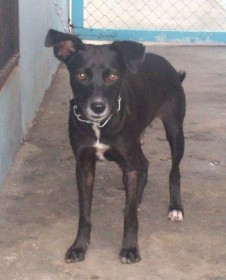On other occasions, you may notice only the symptoms that I have previously described (Pet Corner November 14, 21, 28), and according to the reactions of the dog, you can be pretty certain what the poison was (eg, toad poison). The important message here is that you should always try to identify the poisonous material (chemical) or the encounter with a poisonous animal or plant.

Most products containing poisonous chemicals have labels which tell you what the harmful substances are (another reason for the label to be in a language which you can read). Many labels would also have the antidotes to the poison, should the latter get into the animal’s body. If not, you should call your veterinarian or the nearest pharmacist or doctor. All of these professionals should be capable of giving you sound advice.
Now there are four immediate actions you can take to counteract a poison.
(i) You can eliminate the ingested poison by causing the dog to vomit.
(ii) You can try to delay the absorption of the poison into the animal’s body.
(iii) You can attempt to speed up the passage of the poison through the animal’s body.
(iv) You can administer an antidote, especially if it is documented on the label or in the accompanying insert.
Let’s look at point (i):
How to cause vomiting
I usually advise pet owners (who are already full of panic and some of whom are already beginning to embark on a guilt trip) to induce vomiting by administering one to three teaspoonfuls (according to the size of the dog) of 3 per cent hydrogen peroxide orally. The pet owner should do this every 10 minutes, three applications in all.
A teaspoon is equal to 5 mls. If you have a syringe (and you should, as part of your home first-aid kit), pull up 5 mls (=5 cc) of the 3 per cent hydrogen peroxide and leak (don’t squirt) it into the back of the dog’s mouth. Ten minutes later, you will repeat the exercise, and then 10 minutes later again.
Vomiting can be induced also by placing one-half to one teaspoon of salt at the back of the dog’s mouth on the tongue. Some people might have syrup of ipecac in their medicine box. That’s a good emetic. You can use one teaspoonful of the syrup for every 10 pounds of the dog’s body weight. You have to average your pet’s weight, but if you have been visiting your vet often enough, you would have a pretty good idea how much the animal weighs.
Over my years of interacting with pet owners, many already are feeling ‘guilty’ that they might have done something wrong, so they clean up. It is the patient vet who tries to extract slowly but persistently the truth from the owner. Well, please dear care-giver, do not keep anything (irrespective of how insignificant you may think it is) back from your vet. You and he/she are partners in trying to pinpoint the cause(s) of the ailment/symptoms.
Have no fear in admitting that you sprinkled sevin dust on the dog yesterday. After the dog/cat’s life has been saved, you and your vet will have a good laugh at your unwillingness to divulge crucial information and how the vet had to pull the facts out of your mouth.
Please note that there are special conditions which will preclude you trying to make your dog vomit. Do not induce vomiting if the animal:
(1) has swallowed an acid, alkali, solvent, or heavy duty cleaner;
(2) is severely depressed or comatose;
(3) has swallowed a petroleum product;
(4) has swallowed a sharp object (which could lodge in his oesophagus or perforate his stomach as he retches);
(5) has swallowed (or has been mistakenly given) a sedative.
NB: If more than two hours have passed since the poison was swallowed, it doesn’t make much sense to induce vomiting, because the poison would have gotten into the entire physiological system at a cellular level.
We will continue with the treatment possibilities next week.
Please implement disease preventative measures (vaccinations, routine dewormings, monthly anti-heartworm medication, etc) and adopt-a-pet from the GSPCA’s Animal Clinic and Shelter at Robb Street and Orange Walk, if you have the wherewithal to care well for the animals. Do not stray your unwanted pets, take them to the GSPCA’s Clinic and Shelter instead. If you do not wish your pet to have puppies or kittens, you may exploit the GSPCA’s free spay and neutering programme. If you see anyone being cruel to an animal, or if you need any technical information, please get in touch with the Clinic and Shelter by calling 226-4237.







